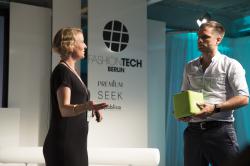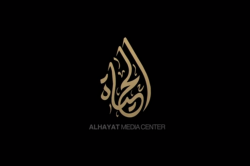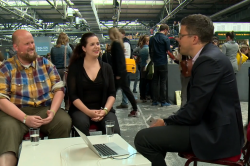bitnik_portrait_studio_quer_bw_905.jpg

Inclusion, exclusion and (supposed) interpretive power are all issues that re:publica cares about. “We are convinced that art has the duty to illuminate borders, and to address contemporary social issues as well.” Although we would agree, the statement comes from the Swiss media collective !Mediengruppe Bitnik. The group said so on the occasion of their piece, "Random Darknet Shopper", being confiscated by the Swiss prosecution in January this year.
So will we now have to have robots “arrested” too? This is one of the fascinating questions raised in the debate around Artificial Intelligence. Artist team Domagoj Smoljo and Carmen Weisskopf programmed a bot – a type of software that performs automated tasks online – for their exhibition, “The Darknet – From Memes To Onionland. An Exploration” in St. Gallen in Switzerland. With a 100 Dollar weekly budget, the bot would independently order random products on the Darknet. In this secluded peer-to-peer network, there is a lively virtual marketplace of all kinds of legal and illegal goods. So the programme purchased, amongst other things, some MDMA pills, a pair of fake jeans, and the scan of a Hungarian passport, all home delivered.
Even before the drugs arrived, the exhibition had been all over the news. Finally, the Gendarmerie moved in, on the grounds of “protecting third parties”. But can an algorithm become a crime? Certainly, once it regains an interface with us as consumers... Bitnik’s digital artwork explores and addresses several issues at once: the computer-aided automation of our everyday tasks, the supplies and trust levels in illegal online markets, and the Darknet as a surveillance-free space, in a negative as well as positive sense. Bitnik rearranges familiar images to reconsider established structures and mechanisms – and hacking is one of their main creative strategies.
Core topics of the digital society, such as copyright, privacy, unlawfulness or resistance, are all imprinted into their work – the medium is the message. The group caused a similar sensation in early 2013, with their art project “Delivery for Mr Assange”. Bitnik had a parcel delivered to Wikileaks founder Julian Assange in the Ecuadorian embassy in London – one of the best- guarded men in the world. A camera documented the parcel’s journey through a hole in the packaging, and transmitted the real-time images to the Internet. And the parcel did in fact, and in that sense, became “Live Mail Art” and system test all at once. And London as a target, with its record-breaking CCTV camera density, presented itself as an ideal playground. And before that, the artists intervened in public (monitored) space with their project “Surveillance Chess”, by replacing the feed of a security camera with an invitation to play chess, reversing the roles and turning the watchmen into actors in their own game.
This is the kind of effect we hope to see in May, too. Art is a dedicated means of discourse – !Art as Evidence!



